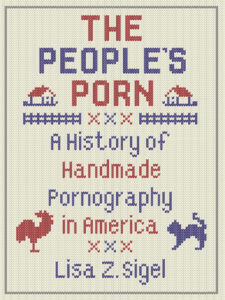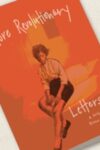
[Reaktion Books; 2020]
One of my favorite places to visit as a kid was the Grafton Flea Market, an open-air swap meet/antiques market in Massachusetts. In addition to the fireworks, hermit crabs, and switchblades, I recall a few dirty crafts and lowbrow trinkets: a trucker cap depicting a fisherman standing up to his waist deep, while beneath the surface, a fish engulfed his penis like a worm; a circular ashtray decorated with a silhouette of a man and a woman copulating; and finally, I cannot forget the penis pipe with a bowl for “tobacco” in the scrotum. I remember the adults around me scoffing at these “trashy” objects, but in the dirty crafts’ irreverent depictions of “privates” I saw freedom and playfulness. Upon learning about The People’s Porn: A History of Handmade Pornography in America, by Lisa Z. Sigel, a historian from DePaul University, the same interest that captivated me at the flea market beckoned me to read the book. Sigel’s research glimpses into the history of sexuality in America through handmade pornographic objects, asking what handmade “trashy” sex objects reveal about our culture and its historical expressions of sexuality. The People’s Porn provides timelines and contexts showing that, no matter what obscenity laws our nation puts in place, individuals have always expressed their sexuality through art and crafts.
The book begins with a history of handmade pornographic objects between 1830 and 1930, the kind of items you would expect in a material culture study of sexual crafts and art, such as a naked lady scrimshaw. The second chapter delves into one of the main tensions in the study, the give and take between commercial and handmade porn from 1910 to the 1970s. The author sets the cutoff point in the 70s because Polaroid cameras, and soon after camcorders, made producing homemade pornography so easy that commercial pornography absorbed homemade pornography under the category “amateur” and the commercial/homemade/handmade distinction becomes too blurred. Chapter 3 examines items the Kinsey Institute collected from men in prison, while chapter 4 examines how the art world interacted with handmade pornography in the mid twentieth century. Then, the final chapter, looks briefly at amateur pornography since the 1970s.
The distinction between handmade and homemade is important. In this book, homemade pornography means photography and video; handmade refers to arts, crafts, and objects. The People’s Porn looks only at handmade pornography.
There are several definitional arguments that challenge readers of The People’s Porn, the most immediate being the definition of pornography. Of course, pornography is hard to define, so hard in fact that Justice Potter Stuart’s statement from the Jacobellis v Ohio obscenity case has become shorthand for things that are hard to define – “I know it when I see it.” Sigel doesn’t get much closer, pointing to the “contingent nature” of porn in history in which “historians recognize that objects like an erotic novel or figurine might have been understood as pornographic in the past, even if we do not look at them that way now.” The People’s Porn, the author claims, “tries to capture a sense of that contingency. It shows how some objects became art while others did not and explores how shifting definitions leave behind an impoverished vision of what pornography can mean.”
Indeed, the book takes a broad view of what can be defined as pornography, which is fine, but it is hard to say if these items were viewed as pornography at the time of their creation, by their creators, or by the people who later handled, traded, bought, or sold them. Of course, it would be too much to ask for Sigel to come up with a definition of pornography once and for all. Desire is highly personal and what is erotic changes from person to person. Furthermore, it seems expedient to use “handmade porn” as a shorthand for the objects discussed in the book. Still, perhaps acknowledging the nebulous definition of pornography and providing a clear list of criteria for inclusion in this specific study (for example, criteria might include violated obscenity laws as the time, depicted intercourse, expresses a sexual fantasy, or, expresses/invokes arousal) would have sufficed. When the “pornographic” nature of an object is unclear, it can be difficult to see how it relates to the central ideas of the book.
To provide a simple example, chapter one includes 19th century pennies vandalized to change “cent” to “cunt.” If they changed “shot” to “shit” or “pass” to “piss,” replacing anatomical/sexual obscenity with scatological obscenity, what would be the difference? Is there a difference between pornography and dirty jokes?
In the instance described above, the dirty penny falls within Sigel’s contingency definition well enough, and the passage is short enough, that the reader can accept the object’s subversive obscenity and not quibble. However, when Sigel extensively addresses Henry Darger, a famous “outsider artist,” I wanted a clearly delineated set of criteria for inclusion in the book. His work, called The Realms of the Unreal, incorporated drawing, tracing, collage, and text to tell fantastic and gruesome tales. It follows a family of hero-sisters, the Vivian Girls, as they fight evil forces that would enslave all children. My inability to reconcile Darger’s work with a clear set of criteria for pornography made his work feel out of place alongside overtly pornographic work such as “A Pretty Girl’s Companion and Guide to Love’s Sweetest Delights,” a graphically written and illustrated how-to guide from the 1870s that narrates sex acts in detail and something that recognizable as pornography today.
Because The People’s Porn devotes many pages to Darger, I would like to explain the definitional difficulty here further. His landlord discovered, shared, and eventually sold Realms of the Unreal, after the artist’s death. Darger left no commentary, so scholars and viewers must make meaning of his work without insight from its creator. However, what we do know about Darger suggests we should not project our expectations of a typically-abled person onto this artist. Darger spent part of his childhood in a home for “feebleminded” children and reported experiencing and witnessing significant abuse, which lead to a life-long interest in protecting children. Aside from one relationship, Darger lived an extremely isolated life and what little is known about him includes serious speculation about mental illness.
(Trigger warning: the following discussion of Darger’s work mentions sexual abuse.) Darger’s work is not primarily sexual, that is, the Vivian Girls and other children are often engaged in adventures or activities where sexuality is not the focus. The potentially pornographic aspects of The Realms of the Unreal depict abuse, not intercourse. The Vivian girls sometimes find themselves trapped and abused by adult men. It’s not surprising that viewers see these images as sexual, but, given Darger’s life, should we sexualize his depictions of abuse or question those impressions? Discussions of Realms of the Unreal often question why Darger drew the girls naked with male genitals, but representing intersex bodies is not inherently pornographic. Without clear criteria for his inclusion, I was unable to accept the contingent nature of pornography in the case of Henry Darger.
Chapter 3, “Men and Time: Prison Pornography, 1940s to 1960s,” dives into the Institute for Sex Research’s prison pornography collection. The Institute for Sex Research is now called the Kinsey Institute, named after famed sexuality researcher, Alfred Kinsey. From the 1940s to the 1960s, prison officials supplied the Institute for Sex Research with obscene materials confiscated from prisoners. Kinsey and his researchers visited prisons around the country, interviewing prisoners and prison officials. Though the discussions of the Kinsey Institute and its projects are fascinating, “Men and Time” includes many descriptions and images of sexual violence. Readers with trauma or indisposed to reading about sexual violence may wish to skip this chapter.
“Men and Time” includes many drawings. Some of the images gathered from prisons are well-drawn while others appear childlike or disfigured. For example, one prisoner depicted intercourse but did not feel the need to draw a head on the man, or arms on either the man or the woman. Not all prisoners’ drawings were as rudimentary, though. Some told stories in comic book style or drew images with real skill. However, even the more refined drawings taken from the prisons depicted violence towards women.
At the end of the chapter, Sigel observes, “in many ways, prison pornography echoed the wider range of handmade and homemade objects. In terms of themes and subjects, prison pornography reflected the larger world of sexual desires, rather than being atavistically set against it. Imprisoned men created images that mirrored subjects found in both commercial and homemade and handmade pornography.” While this is no doubt true in some instances, the clear contrast between the objects and images in this section and work described in other chapters makes it hard to draw the connection the author suggests. The other chapters show people engaging playfully with sexuality, from simple depictions of erections or to artistically refined fantasies. In contrast, the “Men and Time” chapter is dominated by sexual violence.
Chapter 4, “The Postwar World and the Making of a People’s Pornography, 1940s to 1970s,” introduces a wide array of mid-century artists who produced handmade pornography. From pin-ups on airplanes to toothpick holders with erections to phallic aprons, this chapter fulfilled my longing to learn about the dirty crafts I saw at the flea market so many years ago. Many of the creators remain nameless, but when the artifact was created by a notable artist, culture sometimes re-interpolated homemade pornography as art. Here again we find definitional arguments: when are dirty crafts folk art? When are they art brut or outsider art? When are they fine art? Sigel explains that classification is somewhat arbitrary, but there is some prejudice against handmade porn overall in how the art world interacts with these objects.
The book asks many more questions. How does homemade porn explore feminism? What varieties of homemade pornography do artists from traditionally marginalized or under-represented cultures create? How does capitalism attribute meaning to these objects and what does that mean for how we understand them? Through example after example – Steven Ashby’s wooden copulations to Elaine Bennett’s “Bitch Box” (a labia change purse); from threesomes with Batman, Robin and Catwoman to gay college orgy pamphlets – we encounter the proliferation of handmade porn.
Of these items and their historical context, Sigel writes:
sex, formerly a place of laughter and scorn, soon became a place for pleasure, joy, and political intervention. Sex began to carry new meanings. It became a means of self-expression worthy of holding onto and savoring; it became violent, so that violent themes in commercial culture could be explored in handmade objects; and it became professionalized as craft culture entered museums and galleries. Concerned with issues of race and sex, inspired by consumer culture, inclusive, navel-gazing (both literally and figuratively closed parentheses, self-referential, violent, and political, a people’s pronoun if he had finally arrived.
The final section, “Marketing Authenticity, 1970s Onward” looks at “the development of new technologies for the creation of amateur pornography and the commercialization of handmade and homemade objects.” Here, homemade and commercial merge. Polaroids and camcorders let people record themselves at home. The amateur category exploded in magazines and on VHS. This book does not explore the subject of user-made pornography distributed online, which is understandable, but does feel like a missing chapter from this study. Nudes on Snapchat, uploaded content on Pornhub, and topless photos on Reddit GoneWild must be the largest proliferation of homemade pornographic images ever. Understandably, digital artifacts in material culture can be studied apart and one book can’t contain everything. I will say that, given the care and clarity of The People’s Porn, if Lisa Sigel felt like following up on homemade pornography in the digital age, I would certainly be happy to read that book too.
Eric Aldrich’s recent work has appeared in Hobart, Manifest West, The Worcester Review, and The Arcanist. His novella, Please Listen Carefully as Our Options Have Changed, is forthcoming from Running Wild Press. You can follow Eric via ericaldrich.net or @ericjamesaldrich on Instagram.
This post may contain affiliate links.







